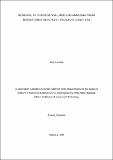| dc.description.abstract | Oldoinyo Lengai mountain located in Northern Tanzania is the only active natrocarbonatite volcano with unusually alkali-rich natrocarbonatites which are not found elsewhere in the world. Volcanic ash formed earlier during eruptions was collected from different sites along the mountain, and its potency to adsorb hydrogen sulfide (H2S) and ammonia (NH3) from biogas was investigated. The samples were calcinated at different temperatures (550–850 °C) and were characterized by X-ray fluorescence, scanning electron microscopy and X-ray diffraction techniques. The on-site adsorption experiments were conducted at the biogas digester at ambient conditions. The calcinated ash was packed into the reactor bed, biogas allowed to pass through the adsorbent, and the inlet and outlet concentrations of H2S and NH3 were measured. The height of the site where the adsorbent was taken from, calcination temperature, biogas flowrate and mass of the adsorbent were variable parameters and found to influence greatly on the efficiency of H2S and NH3 removal. The efficiency increased with calcination temperature raise and mass of adsorbent and decreased with flowrate increase. The samples collected from the top site of the mountain and calcinated at 850 °C exhibited the best sorption performance (SC) of 1.0 g of S/100 g of adsorbent when the mass of adsorbent of 1 g and the biogas flowrate of 0.002 m3/min were used as standard parameters for this study. Chemisorption of H2S was confirmed via bornite and hexahydrite, while CO2, confirmed via trona, pirssonite and nahcolite while NH3 was detected by gas analyzer. | en_US |

